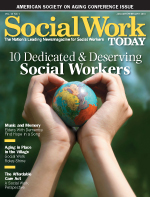|
Relational Resilience in Treating Adolescent Substance Use As conceptualized by scholars at the Stone Center at Wellesley College, relational resilience involves the capacity to move back into growth-promoting connections after an acute disconnection or times of stress. For parents and teens dealing with the issue of adolescent addiction, the relational rupture can feel irreparable. According to Sarah Barrett, LCSW; Galeet Farrow, LPC; and Jake Neff, MSS, LSW, substance abuse in adolescents typically manifests itself through problem behaviors, not overt signs of drug abuse. As adolescents begin to display negative behaviors and their functioning declines, parental fear and frustration typically translate into tensions between parents and children. On many levels, addiction is about relational disconnect from the self and others. Activating the relational resiliency between parents and children is both a therapeutic goal and an agent of change in the treatment of adolescent substance abuse. Drawing on their own personal experiences as mother and son, Barrett and Neff offer a unique perspective on the relational resilience that both parents and adolescents can develop through this challenging experience. Parent-Child Dynamics Relational theory emphasizes that psychological growth occurs in relationships. “Healthy attachment starts with an attuned connection between parent and child,” Barrett says. “Knowing your parent is able to listen without judgment, notice your feelings, support your strengths, and value you as a person is vital to an adolescent’s developing sense of self. But the bond between parent and child is threatened when substance abuse comes into play. There is an understandable tendency for parents to move into anger, disappointment, and a shame-based response to the relationship.” While some adolescent substance abusers come from dysfunctional family backgrounds, even those who come from strong family units are not immune to these struggles. “For teens, because peer influences are so powerful, they are often more interested in the immediate gratification of fitting into the crowd,” says Neff, an adolescent addiction counselor at Rehab After Work/Rehab After School in Philadelphia. “What happens is that parents begin to focus on the negative behaviors of the adolescent, and there’s a disconnect. They no longer look at the child through a loving lens, and their own fears dictate the relationship. In our program, parents and teens participate in a psychoeducational, developmentally informed program of group therapy to facilitate parental attunement, empathic connection, and open communication. We want parents to gain confidence in their ability to support and coach their teen.” Restoring the parent-child bond can have a significant impact on the therapeutic outcome. “Peer influences are important, but the resilience research shows over and over that the primary protective factor is the connection between the adolescent and a caring adult, most often a parent,” Barrett says. Repairing a Disconnect Neff works with parents on prioritizing issues. Parents can get into the mode of lecturing their child in an effort to change unwanted behaviors. “When a parent is constantly lecturing, kids tune it out—everything sounds the same,” Neff says. “So we talk about prioritizing the importance level of the issues that arise with addicted adolescents so that parents aren’t putting Facebook privileges on the same level as more important safety issues. We talk about how to be a calm parent and how to set boundaries without escalating. The parent has the choice to stop the battle of escalation that often ensues. Kids can’t escalate if the parents stop it. It’s impossible to fight with someone that won’t fight back.” It can be difficult for parents to regain confidence in their own parenting skills, Barrett says. “Parents have to learn to tune in to themselves and their child. It’s a challenge for parents to support a sense of autonomy in their child but still keep them safe. The parenting style needs to be firm yet warm, providing clear guidelines and structure. Sometimes we are so focused on keeping our kids safe that we undermine their sense of personal power.” “Often parents feel that that there is no room for negotiation with their kids, but in becoming controlling they lose the connection and the kids drift to peer influence,” Neff adds. The Social Worker’s Role “Recognize that kids will definitely trigger in you a lot of the stuff they trigger in their parents,” Neff says. “And the parents will push you in other ways. So recognize that each of them is just playing out their roles and their pain—it requires compassion for both parties.” “Don’t get discouraged quickly,” Barrett adds. “Therapy is often a cumulative process. There may be relapses. As you actively promote a healthy connection between parent and child and between you and your client, you enlist the client’s own internal capacity for resilience and recovery.” — Lindsey Getz is a freelance writer based in Royersford, PA, and a frequent contributor to Social Work Today.
|

 January/February 2013 Issue
January/February 2013 Issue